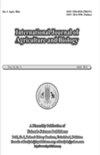Integrated Analysis of Metabolic Profiling of Root Exudates Revealed Potential Allelochemicals from Pseudostellaria heterophylla
Q2 Agricultural and Biological Sciences
引用次数: 0
Abstract
Numerous studies have shown that the rhizosphere allelochemicals closely related to the formation of replant problems in Pseudostellaria heterophylla. In this study, ultra-high performance liquid chromatography-quadrupole time-of-flight mass technology was employed to screen the specific compounds in rhizosphere soil induced the formation of replant disease. Simultaneously, the compounds in cultured seedling of P. heterophylla and corresponding medium were identified using the identical methods to obtain compounds that had not been transformed or degraded by soil microbes. As a result, 176 specific molecules were identified in the rhizosphere soil, 1,011 in the rhizosphere tissue culture medium and 1,447 in plant tissue cultures were obtained by matching to the Traditional Chinese Medicine database. Further analysis found that 21 potential allelochemicals might be directly secreted from P. heterophylla plants, which had not been transformed or degraded in theory. Of which, 13 compounds possessed the allelopathic characteristics based on structural analysis that have been identified in other plants. Simultaneously, eight compounds were only present in the rhizosphere tissue culture medium and plant tissue cultures also were found to possess the allelopathic properties. This study provides an important reference for further screening and identification of specific allelochemicals that related closely to the formation of replant problems in P. heterophylla. © 2022 Friends Science Publishers太子参根分泌物代谢谱的综合分析揭示了其潜在的等化作用
大量研究表明,根际化感物质与太子参补种问题的形成密切相关。本研究采用超高效液相色谱-四极杆飞行时间质谱技术对根际土壤中诱导补种病形成的特定化合物进行了筛选。同时,采用相同的方法对培养的异叶木幼苗和相应培养基中的化合物进行鉴定,以获得未被土壤微生物转化或降解的化合物。结果,通过与中药数据库的匹配,在根际土壤中鉴定出176个特定分子,在根围组织培养基中鉴定出1011个,在植物组织培养物中鉴定出1447个。进一步分析发现,在理论上尚未转化或降解的杂叶植物中,可能直接分泌21种潜在的化感物质。根据结构分析,其中13个化合物具有化感特性,已在其他植物中鉴定。同时,8种化合物仅存在于根际组织培养基中,植物组织培养物也具有化感特性。本研究为进一步筛选和鉴定与异叶补种问题形成密切相关的特定化感物质提供了重要参考。©2022 Friends Science出版社
本文章由计算机程序翻译,如有差异,请以英文原文为准。
求助全文
约1分钟内获得全文
求助全文
来源期刊

International Journal of Agriculture and Biology
AGRICULTURE, MULTIDISCIPLINARY-
CiteScore
1.70
自引率
0.00%
发文量
40
审稿时长
5 months
期刊介绍:
Information not localized
 求助内容:
求助内容: 应助结果提醒方式:
应助结果提醒方式:


